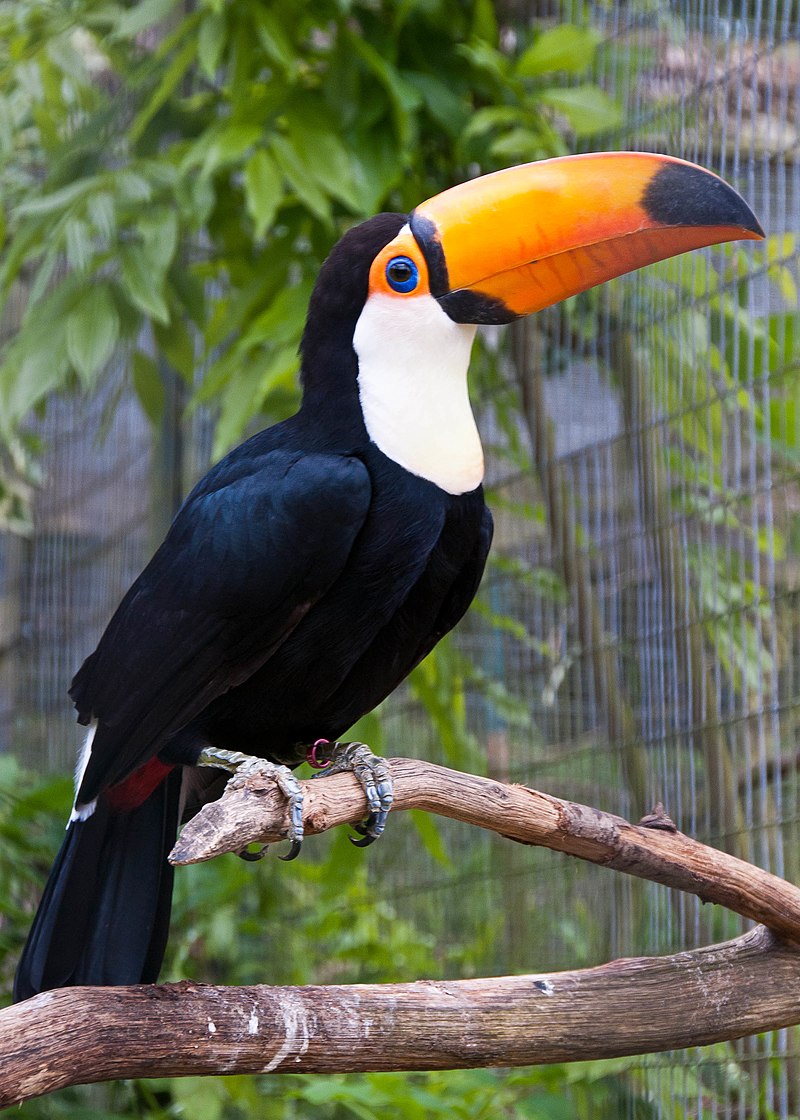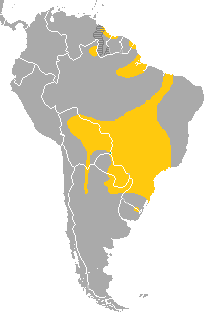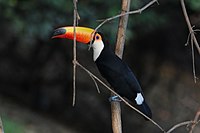
Taxonomy and systematics
Subspecies
Two subspecies are recognized:[2]- R. t. toco - Statius Müller, 1776: Found in the Guianas, northern and north-eastern Brazil and south-eastern Peru
- R. t. albogularis - Cabanis, 1862: Originally described as a separate species. Found in eastern and southern Brazil, northern Bolivia, Paraguay and northern Argentina
Description
The toco toucan has a striking plumage with a mainly black body, a white throat, chest and uppertail-coverts, and red undertail-coverts. What appears to be a blue iris is actually thin blue skin around the eye. This blue skin is surrounded by another ring of bare, orange skin. The most noticeable feature, however, is its huge bill, which measures from 15.8 to 23 cm (6.2 to 9.1 in) in length, which is yellow-orange, tending to deeper reddish-orange on its lower sections and culmen, and with a black base and large spot on the tip.[3] It looks heavy, but as in other toucans it is relatively light because the inside largely is hollow. The tongue is nearly as long as the bill and very flat. This species is the largest toucan and the largest representative of the order Piciformes.[4] The total length of the species is 55–65 cm (21.5–25.5 in). Body weight in these birds can vary from 500 to 876 g (1.102 to 1.931 lb), with males averaging 723 g (1.594 lb) against the smaller female, which averages 576 g (1.270 lb). Among standard measurements, the wing chord is 22 to 26 cm (8.7 to 10.2 in), the tail is 14.1 to 17.9 cm (5.6 to 7.0 in) and the tarsus is 4.8 to 6.5 cm (1.9 to 2.6 in).[3] Other than the size difference, there is no external differences between the sexes. Juveniles are duller and shorter-billed than adults. Its voice consists of a deep, coarse croaking, often repeated every few seconds. It also has a rattling call and will bill-clack.Distribution and habitat
It occurs in northern and eastern Bolivia, extreme south-eastern Peru, northern Argentina, eastern and central Paraguay, eastern and southern Brazil (excluding southern Rio Grande do Sul, the dry regions dominated by Caatinga vegetation and coastal regions between Ceará and Rio de Janeiro). Other disjunct populations occur along the lower Amazon River (Ilha de Marajó west approximately to the Madeira River), far northern Brazil in Roraima, and coastal regions of the Guianas. It only penetrates the Amazon in relatively open areas (e.g. along river corridors). It is resident, but local movements may occur.It is, unlike the other members of the genus Ramphastos, essentially a non-forest species. It can be found in a wide range of semi-open habitats such as woodland, savanna and other open habitats with scattered trees, Cerrado, plantations, forest-edge, and even wooded gardens. It is mainly a species of lowlands, but occurs up to 1,750 m (5,740 ft) near the Andes in Bolivia. It is easily seen in the Pantanal.
Behaviour and ecology
The toco toucan eats fruit (e.g., figs and Passiflora edulis) using its bill to pluck them from trees, but also insects, frogs, small reptiles, small birds and their eggs and nestlings. The long bill is useful for reaching things that otherwise would be out-of- reach. It is also used to skin fruit and scare off predators which include jaguars, snakes, and weasles.[5] It is typically seen in pairs or small groups. In flight it alternates between a burst of rapid flaps with the relatively short, rounded wings, and gliding. Nesting is seasonal, but timing differs between regions. The nest is typically placed high in a tree and consists of a cavity, at least part of which is excavated by the parent birds themselves. It has also been recorded nesting in holes in earth-banks and terrestrial termite-nests. Their reproduction cycle is annual. The female usually lays two to four eggs a few days after mating. The eggs are incubated by both sexes and hatch after 17–18 days. These birds are very protective of themselves and their chicks.The bill is the largest relative to body size of all birds providing 30 to 50% of its body surface area, although another Neotropical species, the sword-billed hummingbird, has a longer bill relative to its body length.[6] It was called by Buffon a “grossly monstrous” appendage.[7] Diverse functions have been suggested. Charles Darwin suggested it was a sexual ornament: “toucans may owe the enormous size of their beaks to sexual selection, for the sake of displaying the diversified and vivid stripes of colour with which these organs are ornamented".[8] Further suggestions have included aid in peeling fruit, intimidating other birds when robbing their nests, social selection related to defense of territory, and as a visual warning.[6][9]
Research has shown that one function is as a surface area for heat exchange.[6] The bill has the ability to modify blood flow and so regulate heat distribution in the bird, allowing it to use its bill as a thermal radiator.[6] In terms of surface area used for this function, the bill relative to the bird's size is amongst the largest of any animal and has a network of superficial blood vessels supporting the thin horny sheath on the bill made of keratin called the rhamphotheca.
In its capacity to remove body heat the bill is comparable to that of elephant ears.[6] The ability to radiate heat depends upon air speed: if this is low only 25% of the adult bird's resting heat production to as much as four times this heat production. In comparison, the bill of a duck and the ears of elephant can shed only 9 to 9.1% of resting heat production.[6] The bill normally is responsible for 30 to 60% of heat loss. The practice of toco toucans of placing their bills under their wings may serve to insulate the bill and reduce heat loss during sleep.[6] It has been observed that "complexities of the vasculature and controlling mechanisms needed to adjust the blood flow to the bill may not be completely developed until adulthood."[6]
-
-
Adult
London Zoo
Aviculture
Like the keel-billed toucan, the toco toucan is sometimes kept in captivity, but has a high fruit diet and is sensitive to haemochromatosis (an iron storage disease).[10] Also, pet toco toucans must not be permitted to eat mouse (or rat) meat, due to a risk of bacterial infection.[11] There is an ongoing population management plan that should help to revert the decreasing captive population of the toco toucan for Association of Zoos and Aquariums (AZA) member institutions. This is the second management plan that is occurring since 2001.[12]Status
Because it prefers open habitats it is likely to benefit from the widespread deforestation in tropical South America. It has a large range and except in the outer regions of its range, it typically is fairly common. It is therefore considered to be of Least Concern by BirdLife International.






No comments:
Post a Comment
Note: Only a member of this blog may post a comment.